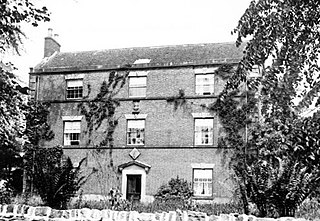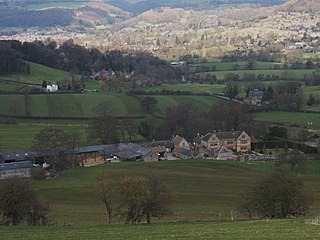
Keele is a village and civil parish in the Borough of Newcastle-under-Lyme in Staffordshire, England. It is approximately three miles (5 km) west of Newcastle-under-Lyme, and is close to the village of Silverdale. Keele lies on the A53 road from Newcastle-under-Lyme to Market Drayton and Shrewsbury. The village is the location of Keele University and Keele Services, a motorway service area on the M6.

Brimpton is a mostly rural village and civil parish in West Berkshire, England. Brimpton is centred 4.5 miles (7.2 km) ESE of the town of Newbury.

Rothley Temple, or more correctly Rothley Preceptory, was a preceptory in the village of Rothley, Leicestershire, England, associated with both the Knights Templar and the Knights Hospitaller.

Ansty is a small village and civil parish in southwest Wiltshire, England, about 6 miles (10 km) east of Shaftesbury. The village is just north of the A30, between Shaftesbury and Salisbury. The parish includes the hamlet of Ansty Coombe.

Temple Normanton is a village and a civil parish in the North East Derbyshire district in Derbyshire, England. The population of the civil parish at the 2011 census was 490.

Yeaveley is a small village and civil parish near Rodsley and 4 miles south of Ashbourne in Derbyshire. The population of the civil parish as at the 2011 census was 396.

Sandon is a village in Staffordshire, about 4.5 miles (7 km) northeast of Stafford. The village is in the Trent Valley on the A51 road.

Waingroves is a large village in the Amber Valley district of Derbyshire, England, approximately two miles away from the town of Ripley. It is in the civil parish of Codnor. In woodland to the south of the village, there are remains of a colliery site.
Stydd Hall (Castle) is a country house located near to the village of Yeaveley, Derbyshire, 15 miles (24 km) west of Derby, close to the A515 between Wyaston to the north, Great Cubley to the south, Yeaveley to the east and Alkmonton to the northeast. Stydd had formerly been an independent township but has all but disappeared: the hall and a farm are all that remains.

Snitterton Hall is a late medieval manor house in Snitterton in South Darley parish, near Matlock, Derbyshire, England, and within the Peak District National Park. It is a Grade I listed building.

Barrow Camera was a Knights Hospitaller foundation in the parish of Barrow upon Trent, Derbyshire, England.

Locko Preceptory was a Preceptory of the Military and Hospitaller Order of Saint Lazarus of Jerusalem, situated just over a mile north of Spondon, Derbyshire; the site is today part of the Locko Park estate. It is the only recorded Lazarite Preceptory in England.

Temple Manor is a scheduled ancient monument and grade I listed building in Strood, Kent. The Manor has been owned by various religious, national and farming owners over 600 years. The building has been added to and adapted over the centuries, but the basic structure is now clearly visible.

Heather Preceptory was a preceptory of the Knights Hospitaller, established in the village of Heather, Leicestershire, United Kingdom.

Withham Preceptory, one of the smallest Knights Templar preceptories in England, was founded, before 1164, at Temple Hill, near South Witham, Lincolnshire, and was abandoned in the early 14th century. The site of the former preceptory at Temple Hill, South Witham. It 'has been largely under pasture' since the Knights Templar left in 1308.

St Wilfrid’s Church, Barrow upon Trent is a Grade I listed parish church in the Church of England in Barrow upon Trent, Derbyshire.

Halston Hall is a Grade I listed building in the parish of Whittington, Shropshire, England. A country house first built around 1690, it was given protected status in January 1952. Alterations were made to the structure for John Mytton by Robert Mylne around 1766-68 and further work was undertaken during the early- to mid-19th century, for some of which time the property was owned by his grandson, also called John but often referred to as "Mad Jack" Mytton.

This is a list of scheduled monuments in the district of South Derbyshire in the English county of Derbyshire.
Yeaveley is a civil parish in the Derbyshire Dales district of Derbyshire, England. The parish contains nine listed buildings that are recorded in the National Heritage List for England. Of these, one is listed at Grade I, the highest of the three grades, one is at Grade II*, the middle grade, and the others are at Grade II, the lowest grade. The parish contains the village of Yeaveley and the surrounding countryside. The oldest listed building in the parish consists of the remains of a preceptory of the Knights Hospitaller. The other listed buildings are houses and associated structures, farmhouses and farm buildings, and a church.




















